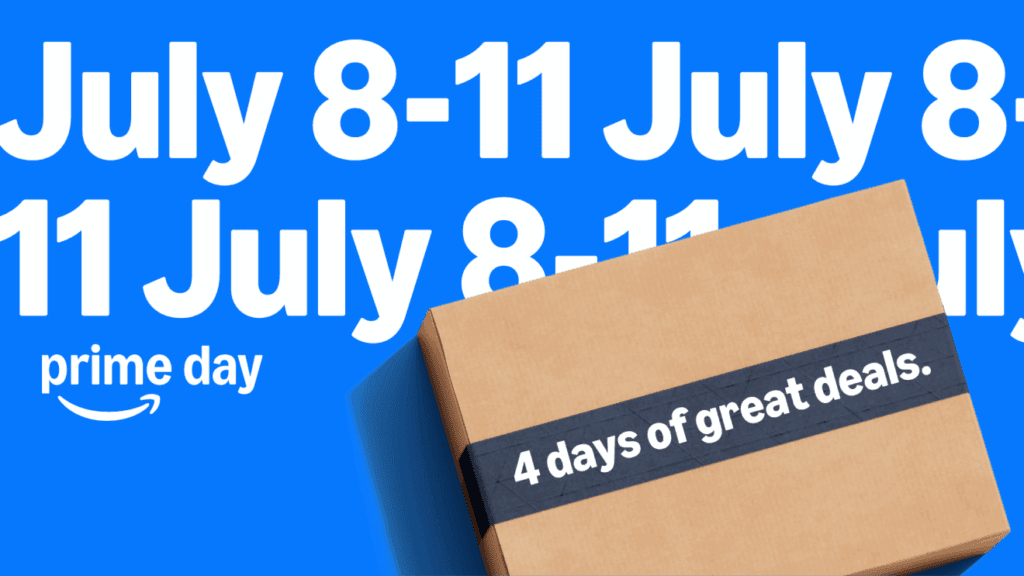Prime Day eCommerce Strategies 2025: Gear Up for Success
Welcome to “The Checkout Point,” the must-listen podcast for all things eCommerce, brought to you by the avid team at blikket.co. As your hosts Max, perpetually fueled by an extra shot of espresso, and Rachel, your serene weekend warrior, we’re here to unpack the latest in eCommerce news, trends, and strategies that could revolutionize your digital marketplace.
This week, as we edge closer to the bustling event that is Prime Day, slated for July 8th to 11th, 2025, it’s timely to discuss strategies that can help your eCommerce business stand out during these highly competitive days of sales frenzy. Prime Day isn’t just a chance to snag deals; it’s a golden opportunity for eCommerce retailers to skyrocket their sales, optimize customer engagement, and enhance brand visibility.
But that’s not all we’re covering today. Get ready for insights on the indispensable role of data-driven design, how giants like Shopify are integrating AI to redefine shopping, and the groundbreaking impact of AI on consumer reviews. Each segment is packed with actionable strategies and insights aimed at transforming browsing consumers into loyal customers.
We’re also diving into the significant strides made by platforms like Amazon and TikTok in reshaping global shopping behaviors and laying the groundwork for a future where cutting-edge technology meets consumer convenience.
Whether you’re looking to inject some rocket fuel into your eCommerce strategy or simply staying updated with the rapid evolutions in online retail, you won’t want to miss out on what we’ve got lined up.
Insights into Prime Day eCommerce Strategies for 2025: Harnessing Data-Driven Design
As the eCommerce landscape continues to evolve, leveraging data-driven strategies has become indispensable, especially during high-stakes sales events like Prime Day. Scheduled for July 8th to July 11th, 2025, Prime Day represents not just an opportunity but a battlefield where only the most meticulously prepared stores thrive. Understanding the impact of data on user experience (UX) and overall revenue, as highlighted in a recent detailed post on our blog, can significantly amplify your Prime Day results.

The Power of A/B Testing in Action
Imagine you’re running two different landing pages to see which one performs better — that’s A/B testing in its purest form. The insights gleaned from such direct comparisons can often be surprising, providing clear directives for future designs and strategies. Our previous experiments with A/B testing at Blikket revealed unexpected winners, offering a profound lesson: what we think might work best might not align with actual consumer behavior.
Enhancing Promotions and UX for Prime Day
Prime Day is not just another date on the calendar; it’s a sprint wherein every minute detail of your UX could be the key to boosting conversion rates or increasing cart sizes. By tweaking your UX based on actionable data — such as engagement metrics from heatmaps — you customize the shopping experience to resonate more effectively with your target customers. This optimization goes a long way in converting visits to sales, particularly when every competitor is vying for consumer attention with attractive promotions.
Utilizing Customer Journey Maps
Delving deeper into the customer’s journey through your digital storefront can unearth a treasure trove of improvement opportunities. Customer journey mapping allows you to visualize every step a customer takes, from landing on your site to completing a purchase. This visual tool points out friction points and highlights areas ripe for improvement. Integrating robust tools like heatmaps, as we discuss in our comprehensive post, provides a clear view of where users pause or drop off, enabling targeted enhancements that could transform potential bounces into sales.
Armed with this data, revamping your eCommerce strategy for Prime Day 2025 could mean the difference between a satisfactory sales performance and an outstanding one. As every seasoned marketer knows, the devil is in the details, and with a data-backed approach, those details could be what propels your Prime Day promotions into new heights of success.
As we edge closer to Prime Day 2025, consider how adopting a data-driven design philosophy could be integral in making data-led decisions that pay off. Remember, it’s about continuous testing and improvement — the landscape of eCommerce never remains static, and neither should your approach to managing it.
Final Thoughts
Taking a dive into data-driven strategies is not just recommended; in a highly competitive digital marketplace, it’s essential. Whether you’re gearing up for Prime Day or aiming to refine your general eCommerce strategy, focusing on data isn’t just playing it safe—it’s playing to win. Visit our detailed blog post on how data-driven design transforms UX and revenue today, and begin turning those insights into actionable, profitable strategies.

Embracing the Future: How Shopify’s Innovations Reshape e-Commerce
As we rapidly advance towards 2025, it’s clear that e-commerce isn’t just evolving; it’s revolutionizing at a breakneck pace. Leading this charge, Shopify has once again captured the spotlight, this time for its ambitious leap into integrating cryptocurrency payments and its strategic embrace of artificial intelligence to streamline business operations. These developments are not just enhancements but potential game-changers for the e-commerce landscape.
Shopify and Mastercard: Pioneering Crypto Payments in E-commerce
Imagine purchasing your favorite skateboard or a trendy new jacket using Bitcoin or Ethereum. Thanks to Shopify’s bold initiative, in collaboration with Mastercard, this could soon be the reality for many. This move isn’t merely about keeping up with technology trends; it’s about setting the stage for the future of financial transactions in e-commerce.
The integration of cryptocurrencies is intended to make these digital payments mainstream, offering a new level of convenience and security, brought by the heavyweight credibility of Mastercard. This could significantly enhance consumer and vendor experiences, providing more flexibility in payment methods. Yet, it also brings to the forefront questions about the accessibility and safety of using cryptocurrencies for the average shopper and small business.
Leveraging AI for Smarter Business Operations
While diving into cryptocurrency is groundbreaking, Shopify’s focus on artificial intelligence could arguably leave an even more profound impact on the e-commerce domain. AI’s potential to reshape staffing and operations is immense, as seen in insights shared by industry giants like Amazon and Duolingo. Shopify joins these ranks in leveraging AI to enhance decision-making processes, from hiring to logistical planning.
This technological evolution points towards a future where e-commerce businesses operate on data-driven insights that significantly reduce guesswork. For instance, a bakery owner can accurately predict staffing needs during holiday seasons, ensuring efficiency without the stress of over or under-staffing. However, the adoption of AI also raises crucial questions about the balance between technological convenience and the personal touch that many small businesses embody.
The Broader Impact on eCommerce Growth
These technological strides are symptomatic of a larger trend observed in Shopify’s recent surge in growth. Such advancements indicate not just recovery but a significant uptick in how businesses adapt to digital transformations. As platforms like Shopify continue to innovate, they empower more businesses to explore online ventures, ensuring a dynamic and competitive e-commerce environment.
This relentless pace of innovation keeps the e-commerce sector vibrant and continuously evolving. It encourages both seasoned entrepreneurs and novices to explore fresh, profitable avenues in the digital marketplace, bolstered by tools and technologies that make these ventures not just feasible but potentially highly successful.
In conclusion, Shopify’s integration of cryptocurrency and AI into their platform isn’t just a testament to their commitment to growth and innovation, but also a beacon for the e-commerce industry, signaling the myriad possibilities that lie ahead. As we move closer to 2025, these prime day eCommerce strategies might just be the beginning of a new era in online commerce.
Unlock Prime Day Success with Proven Ecommerce Strategies for 2025
With 2025 on the horizon, the eCommerce landscape is brimming with innovative opportunities and robust strategies, especially for events like Prime Day. Drawing insights from a recent discussion on Shopify’s forward-looking posts, it becomes evident that the future of eCommerce is not just about selling but creating immersive, personalized shopping experiences. Let’s delve into some actionable strategies that Shopify suggests for those looking to make a splash in the next big sales events like Prime Day.

Personalized Products: The Heart of Future Ecommerce
One notable trend highlighted by Shopify’s exploration of eCommerce is the increasing demand for personalized items. From custom-made journals to tailored gift items, consumers are gravitating towards products that reflect their individuality. For eCommerce businesses, this represents a unique opportunity to differentiate their offerings and build customer loyalty, especially during high-stakes sales periods like Prime Day.
AI: The Game-Changing Technology for Ecommerce
Integrating Artificial Intelligence (AI) can seem daunting, but as Shopify’s resources suggest, it’s more accessible than you think. AI in eCommerce, as per Shopify, is not just about algorithms and data; it’s about enhancing the consumer journey. Tools that manage inventory, customize shopping experiences, or predict purchasing trends can transform how businesses approach major sales days. Using AI to forecast popular items for Prime Day could be the difference between a good sales day and a record-breaking one.
Leveraging Social Media and Early Engagement
Another key strategy is starting your promotions early. According to Shopify, engaging customers via social media teasers and early bird specials can significantly boost interest and sales when Prime Day rolls around. Highlighting upcoming deals on platforms like Instagram or Facebook creates buzz and anticipation, driving both traffic and conversions.
Enhancing Transaction Processes with Modern Tech
The conversation around integrating advanced payment solutions, such as cryptocurrencies, ties back to the crucial aspect of making transactions smooth and secure. On bustling days like Prime Day, ensuring that your eCommerce platform can handle a high volume of transactions reliably is paramount. This not only improves customer satisfaction but also positions your business as a forward-thinking player in the market.
Shopify’s recent insights, particularly their guide on AI and personalized eCommerce, illustrate a landscape ripe with opportunities for smart, adaptable businesses. By embracing these technologies and strategies, even smaller eCommerce players can look forward to carving out their niches and achieving success not only on Prime Day but across all major sales events in the future.
The Ins and Outs of Prime Day eCommerce Strategies 2025
As the digital landscape continues to transform, major e-commerce players are not only enhancing their monetary investments but are also pioneering innovative platforms that could redefine how we shop online. For instance, in a bold move clearly marking the future of e-commerce in Europe, Amazon plans to invest a staggering £40 billion in the UK over the next three years. This hefty investment suggests a significant shift towards enhancing the infrastructure and integration of e-commerce systems across the region.
Simultaneously, the East is not left behind in this digital revolution; TikTok has expanded from being just a hotbed of viral content to a robust e-commerce contender with the recent launch of its e-commerce platform in Japan. This not only boosts the app’s utility but places it at the forefront of transforming consumer habits in Asia.
Meanwhile, Southeast Asia is witnessing its own transformation, with Vietnam spearheading advancements thanks to the synergy between e-commerce and AI. The country’s digital economy boom is palpable, fueled by a robust focus on digital infrastructure that is detailed in the insightful coverage from OpenGov Asia. This deep dive explains how Vietnam’s innovative approach could serve as a model, albeit one that might be challenging to replicate in other markets.
Impact of Prime Day and User Behavior on Future Strategies
Global strategies and investments by heavy hitters like Amazon are not the only factors set to dictate the e-commerce narrative. Consumer behavior and interaction on these platforms hold substantial influence. The staggering number of users influenced by reviews during shopping phenomena like Prime Day highlights a crucial evolution from purely transactional exchanges to deeply social and interactive experiences.
This paradigm shift is critical for e-commerce businesses preparing for 2025 and beyond. Understanding and adapting to these evolving consumer behaviors will be paramount. Platforms that seamlessly blend social interaction with commercial utility, similar to what TikTok and Amazon are pioneering, are set to dominate the landscape. Observing these developments offers a strategic vantage point for predicting and leveraging future e-commerce trends.
In conclusion, as businesses prepare their strategies for the next wave of technological and behavioral shifts in e-commerce, integrating insights from the current evolutions will be key. From monumental investments to innovative platform integrations and changing consumer dynamics, the e-commerce realm is brimming with lessons and forecasts that could shape potent Prime Day strategies in 2025 and beyond.

Understanding the Influence of Consumer Reviews on Prime Day eCommerce Strategies 2025
As we edge closer to Prime Day 2025, consumer behaviors are evolving, and remarkably, a staggering 90% of shoppers are set to be influenced by product reviews, according to a recent survey. This statistic not only highlights the critical importance of reviews in eCommerce decisions but also suggests a seismic shift in how businesses should strategize for these high-stakes sales events.
The Power of Reviews: More Than Just Opinions
It’s not just about the numbers; the qualitative depth of reviews can significantly sway purchasing decisions. Shoppers today, much like our podcast hosts Max and Rachel, often look for that detailed, “through thick and thin” review which tests a product rigorously. This trend puts immense pressure on sellers to ensure not only the quality of their offerings but also their presentation and the customer feedback mechanism they have in place.
Increasing trust through positive reviews is like rolling a snowball down a slope. As it gathers more snow, it grows bigger and rolls faster. Similarly, as products gather positive reviews, they gain visibility and credibility, thereby accelerating sales growth—turning each review into a tiny, persuasive salesperson in their own right.
Generational Differences in eCommerce Preferences
Digging deeper, the influence of brand loyalty and cost-effectiveness seems to vary markedly between generations. Millennials show a slight preference towards brand loyalty, whereas Gen Z is more inclined towards finding the best deals, as detailed in another survey. This divergence necessitates that eCommerce brands dynamically tailor their marketing strategies to cater to the varied preferences across demographic segments.
The Economic Tetris of Tariffs and Pricing Strategies
Moreover, with changing global economic policies, such as tariffs, both consumers and businesses are playing a game of ‘economic Tetris,’ as Max aptly describes. They’re strategically rotating their strategies to fit the changing landscape, aiming to manage costs effectively without sacrificing quality or service. Resources on how these tariffs are reshaping consumer and business strategies were further explored in a recent analysis.
As Prime Day 2025 approaches, tapping into the power of consumer reviews becomes indispensable. Understanding and leveraging these insights can not only boost sales but also build lasting relationships with consumers—relationships based on trust and satisfaction. In the digital age, where a single review can alter the trajectory of a product, businesses need to stay vigilant, ensuring they remain proactive in engaging with customers and integrating feedback to fortify their market presence.
In conclusion, as eCommerce continues to evolve, so does the art of mastering online sales strategies. Reviews, generational shopping preferences, and global economic changes are just some of the variables that play a critical role in shaping successful eCommerce tactics. Businesses that can adeptly navigate this complex terrain are the ones most likely to thrive during Prime Day and beyond.

Revolutionizing Email Marketing: The Power of AI
Email marketing in the realm of eCommerce has always been a cornerstone of customer engagement and sales strategies. But, as the digital landscape evolves, so too must our tools. Enter the latest innovation from Omnisend—an AI-powered suite designed to revolutionize how eCommerce businesses connect with their customers. This breakthrough technology streamlines the email marketing process, allowing for more personalized, and indeed more effective, communication.
Understanding the AI’s Role
Imagine an email popped up in your inbox with a subject line that reads, “Hey [Your Name], check out these new products we picked just for you!” Sounds pretty standard, right? However, what sets Omnisend’s AI-powered tool apart is its ability to learn continuously from your shopping habits and preferences. This isn’t just about bombarding you with random promotional emails. Instead, it’s about delivering content that you are likely to find appealing—effectively mimicking a personal shopper who remembers your tastes but doesn’t crowd your space.
Personalization without the Creep Factor
Given our increasing concerns about privacy and intrusive marketing, one might wonder how this technology manages to personalize without being off-putting. It’s all about striking a delicate balance—making interactions feel helpful, not invasive. The AI designs emails that recall your previous likes and purchases in a way that’s subtle and shopper-friendly, avoiding that eerie feeling as if “someone’s watching.” It’s the difference between an email reminding you that you liked a pair of sneakers and one noting when you last looked at those very sneakers down to the minute.
The Bigger Picture: Global eCommerce Strategies
Omnisend’s AI tool also signals a significant shift towards global eCommerce strategies where personalized local experiences could become the norm globally. This technology doesn’t just adapt to user behavior; it anticipates needs and preferences on a potentially global scale, promising to enhance not just individual shopping experiences but the entire eCommerce landscape. As personalization gets more sophisticated and data-driven, businesses can expect a more engaged and satisfied customer base, translating into better retention and increased sales during high-stakes events like Prime Day eCommerce strategies 2025.
As we further integrate AI in eCommerce, the lines will continuously blur between technology and genuine customer service. Monitoring how these innovations impact both seller tactics and consumer behavior will be key in harnessing their full potential without tipping into overwhelming territory. Truly, we are on the brink of a new era in online shopping—an era ruled by personalization, efficiency, and user-centric strategies, driven by artificial intelligence that knows what you want, sometimes even before you do.
Prime Day eCommerce Strategies 2025: Tapping into China’s Expansion and Bol’s Global Approach
As eCommerce continues to break geographical barriers, the waxing global cooperation orchestrated by significant players like China represents an unfolding playbook for international business. China’s initiatives herald a significant shift, making the once formidable fortress of localized commerce an expansive field of multinational opportunities. For businesses gearing up for Prime Day 2025, this means strategizing around a more globally integrated market scene.
Embracing Global Partnerships
China’s proactive stance in enhancing global eCommerce spaces is tantamount to adding more players to an already dynamic market. Think of it as the online marketplace being a giant multiplayer video game, except the stakes are real, and the players are vying for international audiences. This move could cultivate fertile ground for increased partnerships, smoother trade, and more robust innovation exchanges, offering a treasure trove of opportunities for those outside China.

Challenges for Smaller Entities
While opportunities bloom, so do challenges. The fear of being overshadowed by giant conglomerates is palpable for smaller players. The core concern lies in ensuring that these expanding opportunities do not marginalize entities with lesser resources. This situation necessitates rigorous regulations and robust fair play standards to maintain a level playing field and foster an inclusive market where every player, big or small, gets a fair shot at scoring.
Bol’s Open Doors to Non-EU Sellers
Parallelly, platforms like Bol are not far behind in the race towards global integration. By opening its doors to non-EU sellers, Bol promises a richer, more diversified marketplace. This move, akin to a local farmers’ market turning global overnight, hurls both opportunities and challenges – from the joy of accessing exotic products directly to grappling with logistical nightmares like international shipping and multi-language customer service. Read more about Bol’s recent expansion on ecommerce news.
Leveraging AI for Smooth International Transactions
Advancements in AI could dramatically streamline these extended market dynamics. Imagine leveraging AI for instant translations or for easing customs processes, ushering in an era where shopping from global platforms is as effortless as buying from a local store. This integration of technology could be the linchpin in managing the complexities that come with international transactions, making Prime Day an even more thrilling event for multinational shopping enthusiasts.
As Prime Day 2025 approaches, understanding these nuances and strategically preparing for a more integrated global market will be essential. Businesses must adapt to these shifts with agility, ensuring they leverage both technology and regulatory frameworks to compete effectively on this new global stage. With the right strategies, the extended reach and richness of a diverse marketplace could translate into substantial growth and customer satisfaction alike.
So, whether you’re a small local business or a large corporation, the evolving eCommerce landscape demands a keen eye and a ready strategy to capitalize on the forthcoming opportunities that Prime Day 2025 and beyond will offer. The future of shopping is not just at your doorstep; it’s knocking, ready to deliver the world in your hands.
The Checkout Point: Your Gateway to eCommerce Excellence
As we close another insightful episode of The Checkout Point, it’s clear that the landscape of eCommerce is continuously evolving, pushing boundaries and challenging even the savviest of eCommerce professionals. As Prime Day 2025 approaches, it’s your turn to synthesize these groundbreaking strategies into your sales plans.
From AI-enhanced user experiences to robust data-driven decisions, and even pioneering leaps like Shopify’s into the world of cryptocurrency, there’s a whirlwind of innovation to leverage. Whether you’re a seasoned eCommerce manager or just beginning to navigate these digital waters, integrating these insights could be the difference between a good sales year and a phenomenal one.
Are You Ready for Prime Day 2025?
Prime Day is not just another sales event; it’s a litmus test for your adaptive strategies in the fast-paced world of online retail. With the spotlight on Prime Day eCommerce strategies 2025, ask yourself:
- How are you integrating AI to personalize customer interactions without compromising privacy?
- With Shopify embracing cryptocurrency, is it time to diversify your payment methods?
- Are your data analytics sharp enough to pivot in real-time during high-stakes sales events like Prime Day?
It’s essential to keep these questions in mind as you refine your approaches. Remember, it’s not just about adopting new technologies; it’s about seamlessly integrating these innovations to enhance the shopping experience and boost your sales.
Weigh In on The Evolution of eCommerce
Your feedback and experiences are vital as we explore these complexities together. Have you noticed shifts in customer behavior due to AI integration? What’s your take on cryptocurrency in eCommerce? Share your thoughts and join the conversation below.
Prepare to make the most of Prime Day 2025. Dive deep, plan wisely, and maybe even enjoy a few of Max’s terrible jokes along the way.
Until next time, keep pushing the boundaries of eCommerce and remember, adaptability is your most reliable strategy!
Stay tuned for more at Blikket.co, and don’t forget to check out our full episode for a more comprehensive strategy guide!










